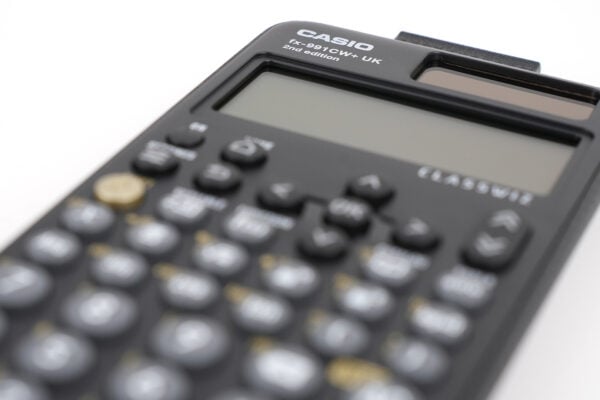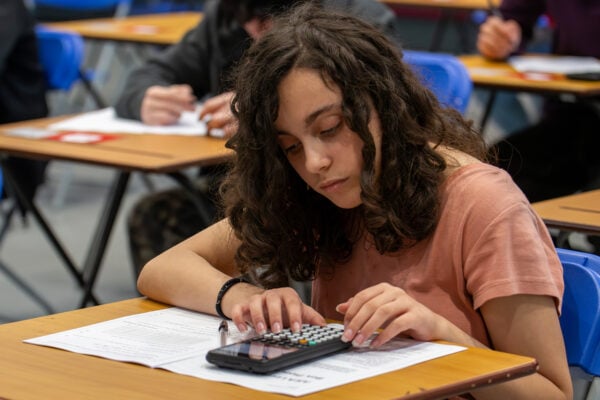How a Casio fx-CG50 Graphic Calculators can enhance students’ understanding of pure mathematics

Typically, when students start A-level mathematics or further mathematics, they’re not always familiar with graphic calculators, which can necessitate a sharp learning curve. Getting students familiar with the fx-CG50 graphic calculator early in their A-level studies helps build confidence and supports their learning.
We sat down with James Davis, Head of KS5 Further Mathematics, Newstead Wood School to explore how he uses graphic calculators as part of almost every lesson to enhance students’ understanding of pure mathematics. For his students, it’s not mandatory to use a graphic calculator. But seeing the benefits in lessons means that the majority quickly choose to use them to enhance their studies.
To help you communicate calculator use in your school, we have developed some calculator use policy templates for you to share with students and parents to reduce the problems caused by poor quality and mixed calculators. (It is better if all students are using the same calculator) You can customise the templates for your school and the level of control you require.
Building familiarity with the graphic calculator
There’s not much point in a student buying a calculator in the months leading up to the final exam, as they simply won’t have the time to learn the features and get used to the technology. Purchasing the calculator at the start of or early in year 12 helps students become familiar with the technology and get the best out of it.
Using it as part of most lessons normalises the technology for the students; it becomes part of their learning routine. It’s a tool they have in their studies to support learning.
There are, of course, alternative technologies and software. But these typically need access to an IT room, tablets or other similar devices. On the other hand, the calculator is always there and available on the desk. You don’t need to wait for the computer to log on or hope the WiFi is working- it’s just there. And importantly, it’s a tool that students can take into the examinations. Using it regularly in class helps build familiarity so that they can use the calculator in an exam scenario. It’s all well and good to derive mathematical concepts using computer software, however, students cannot take this into the exam to help them.
Integrating the graphic calculator in every lesson
The graphic calculator can play an integral role in most mathematics lessons, particularly for students taking Mathematics and especially Further Mathematics A Level.
When teaching function transformations, for example, it’s very quick and easy to explore function transformation, such as y=f(x)+a (“+a” translating graph up “a”), y=f(x+a) (“+a” translating graph left by “a”), y=af(x) (multiplying y ordinates by “a”) and y=f(ax) (dividing x ordinates by “a” ). Students can see the graph moving up, down, left, and right and being stretched as appropriate to the transformation.
The calculator is also useful when introducing differentiation. With the Derivative function on the calculator turned on, you can ask the students, using table mode to produce a table of values of x, y and the gradient and (the derivative) at these points. Then they can work out the rule that if you differentiate x^n, you get nx(n-1) using their GCSE knowledge of linear and quadratic sequences.
Table mode is also hugely valuable in finding roots of equations quickly and also solving problems using the Trapezium rule.
The fx-CG50 is also helpful and incredibly efficient when solving pretty much any equation with a numerical answer. For example, using Newton Raphson’s Method (using graph mode combined with the Ans memory and the differentiation function in run mode). Further the Polynomial Equation Solvers and Simultaneous Equations Solvers are very powerful time saving tools and SolveN in Run mode or using Graph mode solves pretty much every other type of equation. These include trigonometric equations, unknown constants in the in integral limit equations and 1 linear 1 quadratics simultaneous equations to give just a few examples.
The functionality of the graphic calculator for statistics is excellent especially in producing summary statistics, Binomial and Normal distributions, discrete random variables and hypothesis testing.
Alongside this, using the emulator at the front of the classroom allows the whole class to work collaboratively, viewing the same screen and following along with their handset.
Supporting students doing further mathematics
The advanced functionality of the fx-CG50 graphic calculator means that many further mathematics students find it an almost essential addition to support their studies. For example, the matrices functionality is useful for finding the inverse of a 3 x 3. The calculator’s vector functionality, dot products, cross products, etc., is very powerful as it the ability to plot Polar graphs. The statistics components of the further mathematics syllabus is greatly aided by the statistics functionality of the fx-CG50 for example Chi-squared tests, t-tests and confidence intervals.
Also, having the visual prompt and seeing how functions looks helps save time and greatly aids understanding. For instance, when trying to find the limit of something, you can graph it to work out it’s limit. Students can use the graphic calculator as an investigative tool in this context.
Saving time in both lessons and exams
Students can save time for exam questions with method marks by doing much of the heavy lifting on the graphic calculator. Sometimes, there’s quite a lot of work in the mark schemes to move from one mark to the next, which is reduced by using the calculator. Students still have to write down all relevant working to get the method marks, but they can save time – and time saved in exams is a useful tool.
It means students aren’t spending valuable time solving a single equation; they solve it and move on. It also helps in lessons, as saving time means you can go into more depth on topics, focusing on the why and the underlying mathematical concepts rather than solving an equation.
The graphic calculator can support teaching in every area of mathematics, including pure mathematics, statistics, mechanics and discrete mathematics. Bringing the technology into lessons wherever possible helps build familiarity, so students go into their exams confident about getting the best out of their calculator.



